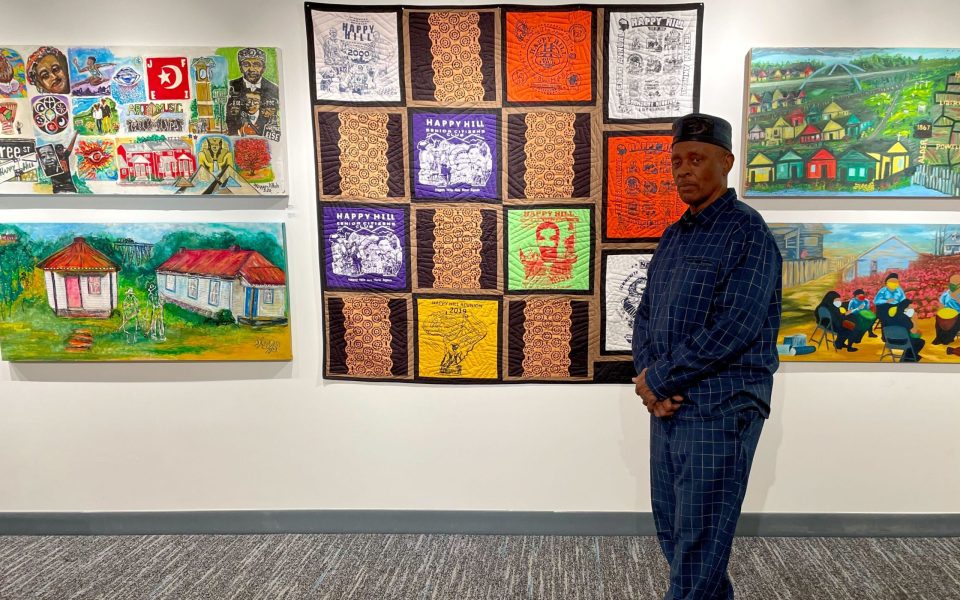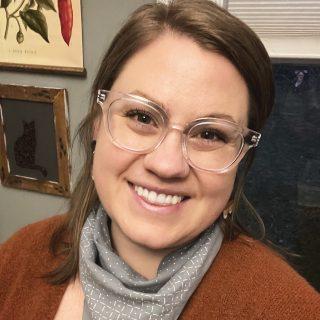Featured photo: Happy Hill Neighborhood Association Art Anthology curated by local artist and Happy Hill resident Kayyum Allah (courtesy photo)
The Milton Rhodes Center Main Gallery in the heart of downtown Winston-Salem is a celebration of Blackness. The bright lights overhead illuminate the light wooden bench that reaches to the ceiling. It’s reminiscent of a picnic bench under the shade of a tree. The walls are covered in Black bodies: working, walking, dancing, communing. Shades range from the fiery orange of an autumn tree to the deep ocean blues of the Fruit of Islam uniform.
The more somber history of the often oppressed and forcibly separated neighborhood known as Happy Hill doesn’t exist in these paintings. These are extollations of community and family. They are portraits of comfort. This gallery is curated to be a celebration.
The Arts Council of Winston-Salem and Forsyth County is currently hosting the Happy Hill Neighborhood Association Art Anthology exhibit, and curator Kayyum Allah wants to ensure it’s an exhibition of joy. The show is up until Feb. 18.
Allah moved to Winston-Salem’s first public-housing development, Happy Hill Gardens, in 1952.
“I was 2 years old; all of my background and educational experiences came out of Happy Hill,” he says. “It was a wonderful place to grow up in. We want to capture the historical value and significance of Happy Hill through art and painting.”

Happy Hill is Winston-Salem’s oldest Black neighborhood, and among the oldest Black neighborhoods in North Carolina. According to the Forsyth County Historic Resources Commission, Happy Hill was the first local community where African-American freedmen were allowed to purchase property. By 1874, construction of the neighborhood had already begun.
“I wanted to concentrate on some of the historical sites that helped build this community,” Allah says.
Allah established the HHNA Art Anthology in 2018, but his desire to reclaim the history of Happy Hill through art began decades before in 1992.

“My specialty was screen-printing at the time,” he says. “Members of the community were having reunions and wanted commemorative T-shirts. So my question was, ‘What do you want on it?’” he laughs as he recalls their responses, “‘I don’t know. That’s why we asked you.’”
In a search for inspiration for the T-shirts, Allah began his research on the history of Happy Hill.
“The neighborhood had really been run down, torn through, removed,” Allah says. “Most of what we had left were memories, and I decided then that I wanted to change that.”
As an HHNA board member, Allah presented his intentions of historical reclamation through paintings, but he also recognized the community’s need for different avenues of art.
“I wanted more people, more artists, more musicians to participate in that endeavor,” he explains. “There were seven of us at the beginning.”
Each artist that takes part in the Art Anthology has either lived in or grown up in Happy Hill, or has ties to someone who currently does.

In August 2021, Winston-Salem City Council voted to name the old footbridge that crossed Salem Creek and connects Happy Hill to then Salem, after Wade B. Bitting.
“Most of the people that lived in Happy Hill worked in Old Salem, or worked downtown at RJ Reynolds plants,” Allah recalls. “The crows’ path to work was across the creek. People were walking on stones to cross and ended up falling in the creek. Mr. Bitting went to city council and told them, ‘If yall want us to work on time, we need a bridge.’”
One of the first paintings at the entrance to the exhibit is Allah’s rendition of Bitting’s Bridge.
“There are things that are happening and that have been happening that are a celebration of resiliency,” explains Shannon Stokes, vice president of strategy and community impact for the Arts Council of Winston-Salem/Forsyth County “We’ve been in conversation with Happy Hill Neighborhood Association with these initiatives that are centered in arts and wellness. This Art Anthology is an ongoing program.”
The arts council funds the Art Anthology through the North Carolina Grassroots Arts Program Federal Funding. Those funds, drawn from the American Rescue Plan Act, require its partners to assign a percentage of funds to support Black, Indigenous or people-of-color arts organizations and programming.
“Kayyum and I were sitting together one day and he was like, ‘I’d love to do an exhibit,’” Stokes says of the curation process. “I love it because it’s this great mixture of Kayyyum’s work and his evolution as an artist, but it really tells the story of Happy Hill. You see the cultural nuances and growth. It’s both an individual’s perspective and a communal perspective. It really is a beautiful exhibition.”
Although so much of Happy Hill’s history is displayed throughout the show, the lack of destructive stories and the systemic racism that the neighborhood has undergone is apparent.

“From my perspective,” Allah explains, “I didn’t experience a lot of that, even though I grew up there all my life. As a unit, Happy Hill was a family oriented community. Our parents kept us away from the harshness that existed.”
Stokes further explains, “There’s room for those conversations as the exhibit is here. But this really speaks to the resiliency and celebration of the people that lived in Happy Hill.”
The vibrant pieces displayed range from acrylic on canvas and particle board to collage.
A quilt hangs on the center of a wall in the middle of the gallery.
“This is one of my favorite pieces,” Stokes says. “It captures and utilizes some of the T-shirts Kayyum mentioned making. I feel like it’s so often missed, that human element of what happens in our communities. There is so much more than the trauma, there’s celebration.”
Allah looks around at the collection and recalls some of his earliest memories in Happy Hill.
“When I was younger, the neighbor across the section of our projects would come on his porch and practice saxophone or trumpet. In the evening, he’d come out and start painting landscapes,” he explains. “He inspired me.”
Join the First Amendment Society, a membership that goes directly to funding TCB‘s newsroom.
We believe that reporting can save the world.
The TCB First Amendment Society recognizes the vital role of a free, unfettered press with a bundling of local experiences designed to build community, and unique engagements with our newsroom that will help you understand, and shape, local journalism’s critical role in uplifting the people in our cities.
All revenue goes directly into the newsroom as reporters’ salaries and freelance commissions.


Leave a Reply